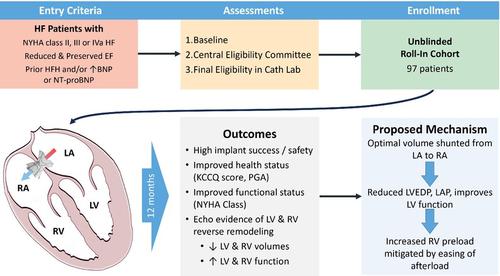当前位置:
X-MOL 学术
›
Eur. J. Heart Fail.
›
论文详情
Our official English website, www.x-mol.net, welcomes your feedback! (Note: you will need to create a separate account there.)
Interatrial shunt therapy in advanced heart failure: Outcomes from the open‐label cohort of the RELIEVE‐HF trial
European Journal of Heart Failure ( IF 18.2 ) Pub Date : 2024-04-02 , DOI: 10.1002/ejhf.3215 Josep Rodés‐Cabau 1 , JoAnn Lindenfeld 2 , William T. Abraham 3 , Michael R. Zile 4 , Saibal Kar 5 , Antoni Bayés‐Genís 6, 7 , Neal Eigler 8 , Richard Holcomb 9 , Julio Núñez 10 , Elizabeth Lee 11 , Michal Laufer Perl 12 , Gil Moravsky 13 , Michael Pfeiffer 14 , John Boehmer 14 , John Gorcsan 14 , Jeroen J. Bax 15 , Stefan Anker 16 , Gregg W. Stone 17
European Journal of Heart Failure ( IF 18.2 ) Pub Date : 2024-04-02 , DOI: 10.1002/ejhf.3215 Josep Rodés‐Cabau 1 , JoAnn Lindenfeld 2 , William T. Abraham 3 , Michael R. Zile 4 , Saibal Kar 5 , Antoni Bayés‐Genís 6, 7 , Neal Eigler 8 , Richard Holcomb 9 , Julio Núñez 10 , Elizabeth Lee 11 , Michal Laufer Perl 12 , Gil Moravsky 13 , Michael Pfeiffer 14 , John Boehmer 14 , John Gorcsan 14 , Jeroen J. Bax 15 , Stefan Anker 16 , Gregg W. Stone 17
Affiliation

|
AimsHeart failure (HF) outcomes remain poor despite optimal guideline‐directed medical therapy (GDMT). We assessed safety, effectiveness, and transthoracic echocardiographic (TTE) outcomes during the 12 months after Ventura shunt implantation in the RELIEVE‐HF open‐label roll‐in cohort.Methods and resultsEligibility required symptomatic HF despite optimal GDMT with ≥1 HF hospitalization in the prior year or elevated natriuretic peptides. The safety endpoint was device‐related major adverse cardiovascular or neurological events at 30 days, compared to a prespecified performance goal. Effectiveness evaluations included the Kansas City Cardiomyopathy Questionnaire (KCCQ) at baseline, 1, 3, 6, and 12 months and TTE at baseline and 12 months. Overall, 97 patients were enrolled and implanted at 64 sites. Average age was 70 ± 11 years, 97% were in New York Heart Association class III, and half had left ventricular ejection fraction (LVEF) ≤40%. The safety endpoint was achieved (event rate 0%, p < 0.001). KCCQ overall summary score was improved by 12–16 points at all follow‐up timepoints (all p < 0.004), with similar outcomes in patients with reduced and preserved LVEF. At 12 months, left ventricular end‐systolic and end‐diastolic volumes were reduced (p = 0.020 and p = 0.038, respectively), LVEF improved (p = 0.009), right ventricular end‐systolic and end‐diastolic areas were reduced (p = 0.001 and p = 0.030, respectively), and right ventricular fractional area change (p < 0.001) and tricuspid annular plane systolic excursion (p < 0.001) improved.ConclusionInteratrial shunting with the Ventura device was safe and resulted in favourable clinical effects in patients with HF, regardless of LVEF. Improvements of left and right ventricular structure and function were consistent with reverse myocardial remodelling. These results would support the potential of this shunt device as a treatment for HF.
中文翻译:

晚期心力衰竭的房间分流疗法:RELIEVE-HF 试验开放标签队列的结果
尽管采用最佳指南指导的药物治疗 (GDMT),心力衰竭 (HF) 的结果仍然很差。我们在 RELIEVE-HF 开放标签转入队列中评估了文图拉分流器植入后 12 个月内的安全性、有效性和经胸超声心动图 (TTE) 结果。方法和结果尽管最佳 GDMT 中 ≥1 次 HF 住院,但仍需要有症状的 HF。前一年或钠尿肽升高。安全终点是与预先设定的性能目标相比,30 天时与设备相关的主要心血管或神经系统不良事件。有效性评估包括基线、第 1、3、6 和 12 个月的堪萨斯城心肌病问卷 (KCCQ) 以及基线和 12 个月的 TTE。总体而言,共有 97 名患者入组并在 64 个地点进行了植入。平均年龄为 70 ± 11 岁,97% 为纽约心脏协会 III 级,一半左心室射血分数 (LVEF) ≤ 40%。达到了安全终点(事件发生率为 0%,p < 0.001)。 KCCQ 总体总结分数在所有随访时间点均提高了 12-16 分(所有p < 0.004),对于 LVEF 降低且保持不变的患者,结果相似。 12 个月时,左心室收缩末期和舒张末期容积减少(p = 0.020 和p = 0.038,分别),LVEF 改善(p = 0.009),右心室收缩末期和舒张末期面积减少(p = 0.001 和p = 0.030,分别),以及右心室分数面积变化(p < 0.001) 和三尖瓣环平面收缩期偏移 (p < 0.001) 有所改善。 结论 无论 LVEF 多少,使用 Ventura 装置进行房内分流是安全的,并且对心力衰竭患者产生良好的临床效果。左心室和右心室结构和功能的改善与逆转心肌重塑一致。这些结果将支持该分流装置作为心力衰竭治疗的潜力。
更新日期:2024-04-02
中文翻译:

晚期心力衰竭的房间分流疗法:RELIEVE-HF 试验开放标签队列的结果
尽管采用最佳指南指导的药物治疗 (GDMT),心力衰竭 (HF) 的结果仍然很差。我们在 RELIEVE-HF 开放标签转入队列中评估了文图拉分流器植入后 12 个月内的安全性、有效性和经胸超声心动图 (TTE) 结果。方法和结果尽管最佳 GDMT 中 ≥1 次 HF 住院,但仍需要有症状的 HF。前一年或钠尿肽升高。安全终点是与预先设定的性能目标相比,30 天时与设备相关的主要心血管或神经系统不良事件。有效性评估包括基线、第 1、3、6 和 12 个月的堪萨斯城心肌病问卷 (KCCQ) 以及基线和 12 个月的 TTE。总体而言,共有 97 名患者入组并在 64 个地点进行了植入。平均年龄为 70 ± 11 岁,97% 为纽约心脏协会 III 级,一半左心室射血分数 (LVEF) ≤ 40%。达到了安全终点(事件发生率为 0%,



























 京公网安备 11010802027423号
京公网安备 11010802027423号